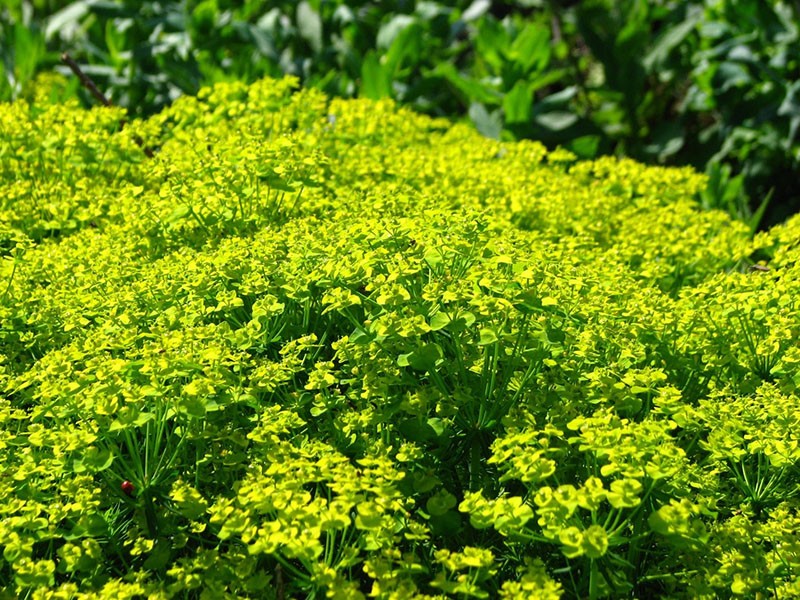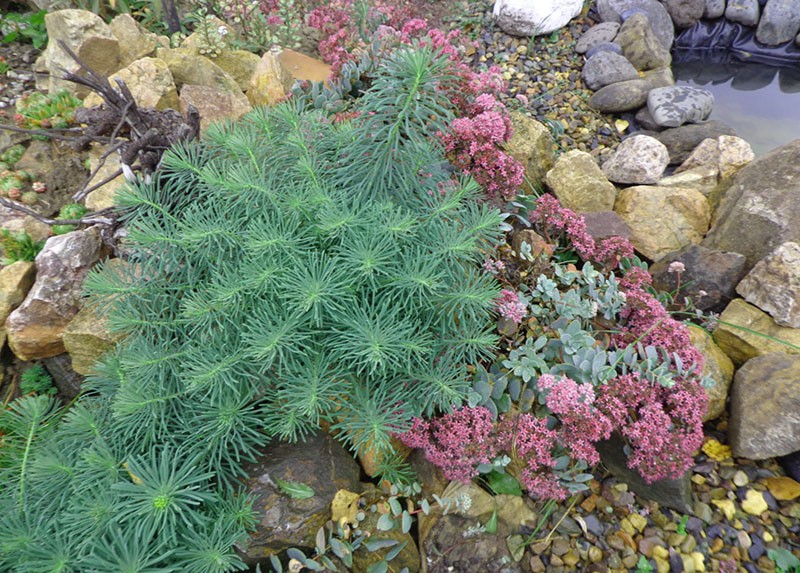Subtleties and nuances of planting and caring for cypress milkweed for colorful flowering
 Cypress euphorbia is a perennial plant that is especially loved by landscape designers. Planting and caring for cypress milkweed has its own characteristics, if observed, you can grow a thick, lush and spectacular deciduous plant. Euphorbia is often used for filling voids and landscaping garden areas, exquisite edging, emphasizing the decorativeness and elegance of flower beds and flower beds.
Cypress euphorbia is a perennial plant that is especially loved by landscape designers. Planting and caring for cypress milkweed has its own characteristics, if observed, you can grow a thick, lush and spectacular deciduous plant. Euphorbia is often used for filling voids and landscaping garden areas, exquisite edging, emphasizing the decorativeness and elegance of flower beds and flower beds.
Botanical description of cypress milkweed


Botanical features of cypress milkweed:
- The root system is massive and extensive, growing vertically into the soil by 2-3 m.
- The bush is compact and neat, reaching 25-50 cm in height.
- Stems are slender, erect. In the lower part, the stems are unbranched, covered with small scaly leaves up to 2-3 cm in size.
- In the upper part of the stems, lateral, leafy shoots are formed, the top of which ends in an inflorescence.
- The crown is branched, consisting of narrow and elongated leaf plates of dark green color with a silvery tint.
- Umbrella inflorescences have a colorful golden-green color. They are arranged in pairs and consist of 10-20 small flowers.

- After the end of flowering, in place of the female flowers, fruits are formed - small boxes, each of which has one seed.
Cypress euphorbia blooms twice a year - in June and in the first half of August. In early, warm spring, the flowering of the plant begins in May.
Planting and caring for cypress milkweed - basic requirements
 In order to get a lush and spectacular garden plant, when planting and caring for cypress milkweed, you need to follow several rules. You can start planting the plant in the second half of April or May. Many gardeners plant euphorbia in September or early October - this way young seedlings will have time to take root before the onset of winter frosts.
In order to get a lush and spectacular garden plant, when planting and caring for cypress milkweed, you need to follow several rules. You can start planting the plant in the second half of April or May. Many gardeners plant euphorbia in September or early October - this way young seedlings will have time to take root before the onset of winter frosts.
Cypress spurge is unpretentious to the composition of the soil on the site. It grows well both on light soils and on gravel, sand or black soil.
Additionally, the site can be fertilized humus or peat - this will provide adequate nutrition for young seedlings.
Site selection and illumination
 When planting milkweed and nursing in the open field, it must be borne in mind that this is a photophilous plant. He needs an abundance of sunlight. You can also choose a light partial shade for planting, but in shaded areas or under tall trees, milkweed growth will slow down. In addition, the lack of sunlight negatively affects the decorativeness of the plant - its flowering weakens, the color becomes less bright, the bush looks untidy.
When planting milkweed and nursing in the open field, it must be borne in mind that this is a photophilous plant. He needs an abundance of sunlight. You can also choose a light partial shade for planting, but in shaded areas or under tall trees, milkweed growth will slow down. In addition, the lack of sunlight negatively affects the decorativeness of the plant - its flowering weakens, the color becomes less bright, the bush looks untidy.
Cypress spurge in the garden is best limited to a kind of "framework", as the shrub grows very quickly in all directions.
Due to the limited territory, it can be given the desired shape during growth, giving the plant a neat and attractive appearance.
Reproduction of cypress milkweed
 Cypress euphorbia reproduces both by seed and vegetative methods. The first method is considered to be easier and simpler, providing excellent germination. Milk cypress seeds can be harvested by yourself or purchased at any gardening store.
Cypress euphorbia reproduces both by seed and vegetative methods. The first method is considered to be easier and simpler, providing excellent germination. Milk cypress seeds can be harvested by yourself or purchased at any gardening store.
In order for the shoots of cypress milkweed to appear in the spring, you can start planting in the fall, planting it directly in open soil. The soil must be well loosened and the seeds evenly distributed.
It is not necessary to cover the sowing site. Cypress euphorbia is highly frost-resistant and tolerates a drop in air temperature to -28 ° C.
You can also plant cypress spurge in April, but the seeds must be fresh. If they hibernated in a warm place, their germination decreases markedly.
 Cypress euphorbia can also reproduce vegetatively. To do this, the underground part of the plant or its roots must be divided into several small parts. You can start planting the received seedlings in April or September.
Cypress euphorbia can also reproduce vegetatively. To do this, the underground part of the plant or its roots must be divided into several small parts. You can start planting the received seedlings in April or September.
Planting scheme for cypress milkweed:
- Prepare planting holes - their depth should be at least 25-35 cm.

- Planting holes should be located at a distance of 30-45 cm from each other, since the plant has a powerful and spreading root system.
- Fill the bottom of the prepared holes with a layer of drainage - pebbles, fine gravel, bark or sawdust.
- Dip the spurge into the hole to a depth of about 20 cm, gently straighten the roots.

- Mix the garden soil with sand and peat or humus and fill the holes with this mixture.
- Water the young seedlings.
Planting cypress milkweed should only be carried out with protective gloves, since the juice of this plant can cause allergic reactions and skin irritation.
Cypress milkweed care rules
 When planting and caring for cypress milkweed, several rules must be observed to ensure active growth and lush flowering twice a year.
When planting and caring for cypress milkweed, several rules must be observed to ensure active growth and lush flowering twice a year.
The plant tolerates moisture deficit very well and quickly adapts to prolonged drought. But excessive watering causes serious harm to it. Euphorbia needs additional moisture only in hot weather with occasional rainfall. If the foliage has faded and the plant has lost its attractiveness, this is a signal of a lack of moisture.
 Additional watering is also required for young seedlings - this speeds up the rooting process. To moisturize, you can use a regular garden watering can, but you need to carefully monitor the volume of water and avoid waterlogging of cypress milkweed.
Additional watering is also required for young seedlings - this speeds up the rooting process. To moisturize, you can use a regular garden watering can, but you need to carefully monitor the volume of water and avoid waterlogging of cypress milkweed.
Perennial grows well without additional feeding. To improve its decorative qualities, you can fertilize it with organic matter in April or early May - peat or humus. If cypress euphorbia is grown on poor soil, it can be fed 2-3 times in the summer with a liquid solution of humus or complex mineral fertilizers.
Trimming and loosening the soil
 For the health and beauty of cypress milkweed, regular loosening of the soil is very important. It helps not only to get rid of weeds, but also to improve oxygen access to the plant's root system.
For the health and beauty of cypress milkweed, regular loosening of the soil is very important. It helps not only to get rid of weeds, but also to improve oxygen access to the plant's root system.
Regular pruning will help maintain the neat and attractive appearance of cypress milkweed. Without it, the shrub grows very quickly, turning into an inconspicuous plant.
 In addition, it is pruning that stimulates the repeated flowering of milkweed, which, depending on climatic conditions, can be observed in August or September. Pruning is best done after flowering is complete, removing any dry and damaged shoots. Also, stems with traces of rot, disease or insect damage are removed.
In addition, it is pruning that stimulates the repeated flowering of milkweed, which, depending on climatic conditions, can be observed in August or September. Pruning is best done after flowering is complete, removing any dry and damaged shoots. Also, stems with traces of rot, disease or insect damage are removed.
Cypress euphorbia is a perennial garden plant that has won the love of many gardeners due to its decorative attractiveness and unpretentious "character". With minimal maintenance, you can get a lush, showy plant that can decorate any flower bed, rockery or flower garden.